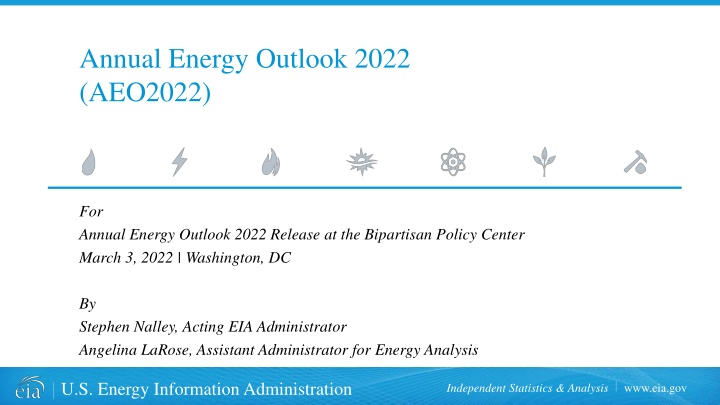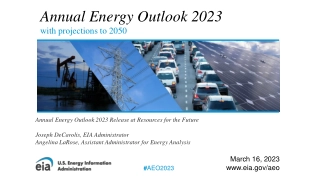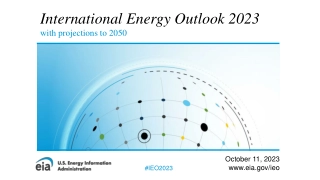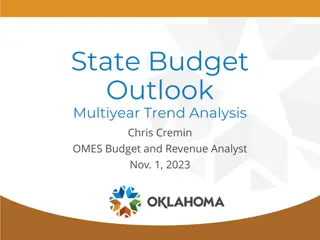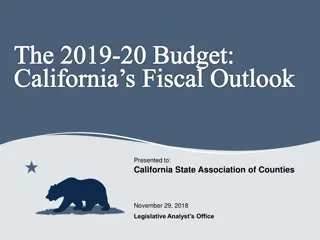Annual Energy Outlook 2022 (AEO2022)
This document presents the Annual Energy Outlook 2022 release held at the Bipartisan Policy Center on March 3, 2022 in Washington, DC. Acting EIA Administrator Stephen Nalley and Assistant Administrator for Energy Analysis Angelina LaRose provided insights and analysis on the energy outlook for the upcoming year.
Download Presentation

Please find below an Image/Link to download the presentation.
The content on the website is provided AS IS for your information and personal use only. It may not be sold, licensed, or shared on other websites without obtaining consent from the author.If you encounter any issues during the download, it is possible that the publisher has removed the file from their server.
You are allowed to download the files provided on this website for personal or commercial use, subject to the condition that they are used lawfully. All files are the property of their respective owners.
The content on the website is provided AS IS for your information and personal use only. It may not be sold, licensed, or shared on other websites without obtaining consent from the author.
E N D
Presentation Transcript
Annual Energy Outlook 2022 (AEO2022) For Annual Energy Outlook 2022 Release at the Bipartisan Policy Center March 3, 2022 | Washington, DC By Stephen Nalley, Acting EIA Administrator Angelina LaRose, Assistant Administrator for Energy Analysis U.S. Energy Information Administration www.eia.gov Independent Statistics & Analysis
AEO2022 Highlights Petroleum and natural gas remain the most-consumed sources of energy in the United States through 2050, but renewable energy is the fastest growing Wind and solar incentives, along with falling technology costs, support robust competition with natural gas for electricity generation, while the shares of coal and nuclear power decrease in the U.S. electricity mix U.S. crude oil production reaches record highs, while natural gas production is increasingly driven by natural gas exports AEO2022 Press Release March 3, 2022 2
AEO2022 examines a range of conditions from 2020 to 2050 Assumptions Current laws and regulations as of November 2021 Current views on economic and demographic trends, and technology improvements Compound annual growth rate for real U.S. gross domestic product (GDP) is 2.2% (Reference case) High Economic Growth case (2.7%) and Low Economic Growth case (1.8%) The Brent crude oil price by 2050 is $90 per barrel (b) in constant 2021 dollars (Reference case) High Oil Price case ($170/b) and Low Oil Price case ($45/b) Oil and natural gas supply cases High: more accessible resources and lower extraction technology costs than the Reference case Low: fewer accessible resources and higher extraction technology costs than the Reference case Renewables cost cases High: no cost reductions in renewable technologies Low: renewables achieve 40% lower overnight capital costs by 2050 compared to Reference case AEO2022 Press Release March 3, 2022 3
Changes in AEO2022: Pandemic and Legislation U.S. gross domestic product assumptions AEO2022 economic growth cases trillion 2012 dollars COVID-19 continues to be a major source of uncertainty, especially in the near term. 2021 $30 history projections AEO2022 includes provisions from the Bipartisan Infrastructure Law $20 High Economic Growth Reference Low Economic Growth $10 $0 2015 2020 2025 2030 AEO2022 Press Release March 3, 2022 4
The U.S. Energy Information Administration (EIA) collects, analyzes, and disseminates independent and impartial energy information to promote sound policymaking, efficient markets, and public understanding of energy and its interaction with the economy and the environment. EIA s role is unique by providing an unbiased view of energy markets, EIA increases transparency and promotes public understanding of important energy issues. EIA has expanded its program in recent years to provide a growing customer base with coverage of increasingly complex and interrelated energy markets. AEO2022 Press Release March 3, 2022 5
AEO2022 core cases vary technical and macroeconomic assumptions Policy assumptions Current laws and regulations as of November 2021 Potential new laws High Economic Growth case High Oil Price case High Oil and Gas Supply case High Renewables Cost case Higher Technical and macroeconomic assumptions Reference case Expected Low Economic Growth case Low Oil Price case Low Oil and Gas Supply case Low Renewables Cost case Lower AEO2022 Press Release March 3, 2022 6
Upcoming AEO2022 Issue in Focus cases vary technical, macroeconomic, and policy assumptions Alternative policies assumptions Carbon fee Sunset credits Extended credits No new pipelines Alternative technical and macroeconomic assumptions Alternative weather assumptions Use cases for battery storage AEO2022 Press Release March 3, 2022 7
AEO2022 Highlights Petroleum and natural gas remain the most-consumed sources of energy in the United States through 2050, but renewable energy is the fastest growing Wind and solar incentives, along with falling technology costs, support robust competition with natural gas for electricity generation, while the shares of coal and nuclear power decrease in the U.S. electricity mix U.S. crude oil production reaches record highs, while natural gas production is increasingly driven by natural gas exports AEO2022 Press Release March 3, 2022 8
Renewables consumption grows fastest but remains far below petroleum and other liquids consumption in 2050 Energy consumption by sector AEO2022 Reference case quadrillion British thermal units Energy consumption by fuel AEO2022 Reference case quadrillion British thermal units 2021 2021 50 50 history projections history projections petroleum and other liquids natural gas electric power 40 40 30 transportation industrial 30 coal other renewable energy nuclear 20 20 10 10 residential commercial hydro liquid biofuels 0 0 1990 2000 2010 2020 2030 2040 2050 1990 2000 2010 2020 2030 2040 2050 Note: Biofuels are shown separately and included in petroleum and other liquids. AEO2022 Press Release March 3, 2022 9
Petroleum and other liquids are largely consumed by sectors with slow turnover to electric equipment New vehicle sales of battery-powered vehicles AEO2022 Reference case millions of vehicles 2021 history projections Petroleum and other liquids consumption by sector AEO2022 Reference case quadrillion British thermal units Light-duty vehicle sales by technology or fuel AEO2022 Reference case millions of vehicles 2021 2021 3 20 30 history projections projections other electric hybrid plug-in electric hybrid battery electric diesel flex fuel gasoline 25 transportation 15 total battery electric including 100-, 200-, 300-mile electric vehicles 2 20 10 15 electric hybrid 300-mile electric industrial 1 10 commercial residential electric power 5 plug-in electric hybrid 5 200-mile electric 100-mile electric 0 0 0 2020 2030 2040 2050 2010 2020 2030 2040 2050 2010 2020 2030 2040 2050 AEO2022 Press Release March 3, 2022 10
Natural gas consumption rises mostly because of industrial use and exports Natural gas disposition and net exports AEO2022 Reference case trillion cubic feet 40 Change in natural gas disposition and net exports AEO2022 Reference case relative to 2021 in trillion cubic feet 9 35 net exports 30 6 net exports 25 electric power electric power commercial transportation industrial residential 20 3 commercial residential transportation 15 10 0 5 industrial -3 0 2030 2040 2050 2020 2030 2040 2050 AEO2022 Press Release March 3, 2022 11
Energy-related CO2 emissions by sector and fuel Energy-related CO2 emissions by fuel AEO2022 Reference case billion metric tons Energy-related CO2 emissions by sector AEO2022 Reference case billion metric tons 2021 2021 3.0 3.0 history projections history projections 2.5 2.5 petroleum transportation 2.0 2.0 natural gas 1.5 1.5 industrial 1.0 1.0 electric power residential coal 0.5 0.5 commercial 0.0 0.0 1990 2000 2010 2020 2030 2040 2050 1990 2000 2010 2020 2030 2040 2050 Note: Series does not include greenhouse gases other than CO2. Industrial sector CO2 emissions do not include process emissions, such as the emissions from cement clinker production. AEO2022 Press Release March 3, 2022 12
AEO2022 Highlights Petroleum and natural gas remain the most-consumed sources of energy in the United States through 2050, but renewable energy is the fastest growing Wind and solar incentives, along with falling technology costs, support robust competition with natural gas for electricity generation, while the shares of coal and nuclear power decrease in the U.S. electricity mix U.S. crude oil production reaches record highs, while natural gas production is increasingly driven by natural gas exports AEO2022 Press Release March 3, 2022 13
The U.S. annual average electricity growth rate remains below 1% across much of the projection period in the Reference case U.S. electricity use growth rate, three-year rolling average AEO2022 economic growth cases percentage growth 2021 history projections U.S. electricity use by end-use sector AEO2022 Reference case billion kilowatthours 2,000 5% onsite generation 4% 1,600 High Economic Growth Reference Low Economic Growth 3% 1,200 purchased electricity 2% 800 1% 400 0% 0 1990 2021 2050 1990 2021 2050 1990 2021 2050 1990 2021 2050 -1% -2% residential industrial commercial transportation 1990 2000 2010 2020 2030 2040 2050 AEO2022 Press Release March 3, 2022 14
Renewables consumption for electricity generation grows significantly in all cases, even as it trades off with nuclear, coal, and natural gas U.S. electricity generation billion kilowatthours Low Renewables Cost case High Renewables Cost case Reference case 2021 2021 projections 2021 projections 2,500 2,500 2,500 history projections natural gas 2,000 2,000 2,000 1,500 1,500 1,500 solar 1,000 1,000 1,000 wind nuclear coal other renewables 500 500 500 0 0 0 1990 2010 2030 2050 2010 2020 2030 2040 2050 2010 2020 2030 2040 2050 Note: Other renewables category includes electricity generation from hydroelectric, geothermal, wood, and other biomass sources. AEO2022 Press Release March 3, 2022 15
Significant renewables growth leads to additional battery storage Hourly U.S. electricity generation and load by fuel for selected cases and years billion kilowatthours AEO2022 Reference case, 2021 300 AEO2022 Reference case, 2050 AEO2022 Low Renewables Cost case, 2050 load 250 load load 200 150 100 50 0 -50 1 5 9 13 17 21 1 5 9 13 17 21 1 5 9 13 17 21 hour of the day curtailment battery storage pumped storage solar wind hydroelectric natural gas combined-cycle natural gas and oil peakers nuclear coal Note: Negative generation represents charging of energy storage technologies such as pumped hydro and battery storage. Hourly dispatch estimates are illustrative and are developed to determine curtailment and storage operations; final dispatch estimates are developed separately and may differ from total utilization as this figure shows. Solar includes both utility-scale and end-use photovoltaic electricity generation. AEO2022 Press Release March 3, 2022 16
AEO2022 Highlights Petroleum and natural gas remain the most-consumed sources of energy in the United States through 2050, but renewable energy is the fastest growing Wind and solar incentives, along with falling technology costs, support robust competition with natural gas for electricity generation, while the shares of coal and nuclear power decrease in the U.S. electricity mix U.S. crude oil production reaches record highs, while natural gas production is increasingly driven by natural gas exports AEO2022 Press Release March 3, 2022 17
Production of U.S. crude oil rises early in the projection and remains largely flat in the Reference case U.S. crude oil production AEO2022 Reference case and side cases million barrels per day North Sea Brent crude oil price AEO2022 side cases 2021 dollars per barrel 2021 2021 $200 25 history projections history projections High Oil Price High Oil and Gas Supply High Oil Price 20 $150 Low Oil and Gas Supply Reference High Oil and Gas Supply Reference 15 $100 Low Oil Price Low Oil and Gas Supply 10 $50 5 Low Oil Price 0 $0 2010 2020 2030 2040 2050 2010 2020 2030 2040 2050 AEO2022 Press Release March 3, 2022 18
The United States remains a net exporter of total liquids and a net importer of crude oil in the Reference case Crude oil trade AEO2022 Reference case million barrels per day Total petroleum and other liquids trade AEO2022 Reference case million barrels per day 2021 2021 16 16 history projections history projections 12 12 imports imports 8 8 4 4 net imports net imports 0 0 2010 2020 2030 2040 2050 2010 2020 2030 2040 2050 -4 -4 exports exports -8 -8 -12 -12 AEO2022 Press Release March 3, 2022 19
U.S. natural gas production grows in most cases, but price and technology assumptions play a central role Dry natural gas production AEO2022 side cases trillion cubic feet 2021 60 history projections High Oil and Gas Supply High Oil Price Reference Low Oil Price 50 40 30 Low Oil and Gas Supply 20 10 0 2000 2010 2020 2030 2040 2050 AEO2022 Press Release March 3, 2022 20
Natural gas and liquefied natural gas (LNG) trade reaches 8 trillion cubic feet in the Reference case U.S. natural gas trade, AEO2022 oil and natural gas supply cases Reference case trillion cubic feet Low Oil and Gas Supply case trillion cubic feet High Oil and Gas Supply case trillion cubic feet billion cubic feet per day 15 15 15 LNG exports net exports 10 10 10 pipeline exports to Mexico pipeline exports to Canada pipeline imports from Canada LNG imports 5 5 5 0 0 0 -5 -5 -5 2020 2030 2040 2050 2020 2030 2040 2050 2020 2030 2040 2050 AEO2022 Press Release March 3, 2022 21
AEO2022 Highlights Petroleum and natural gas remain the most-consumed sources of energy in the United States through 2050, but renewable energy is the fastest growing Wind and solar incentives, along with falling technology costs, support robust competition with natural gas for electricity generation, while the shares of coal and nuclear power decrease in the U.S. electricity mix U.S. crude oil production reaches record highs, while natural gas production is increasingly driven by natural gas exports AEO2022 Press Release March 3, 2022 22
View the full report at eia.gov/aeo Contact us at AnnualEnergyOutlook@eia.gov AEO2022 Press Release March 3, 2022 23
